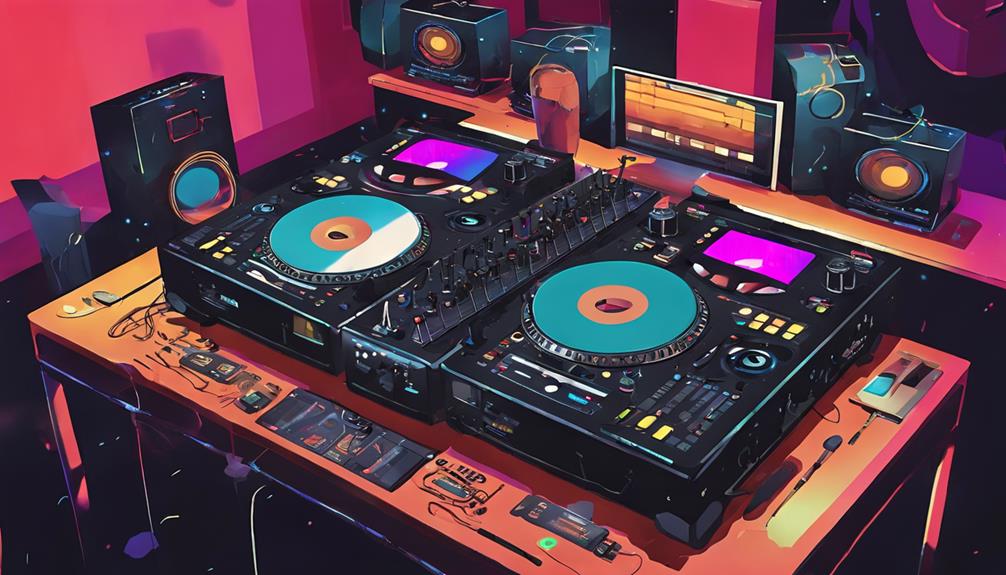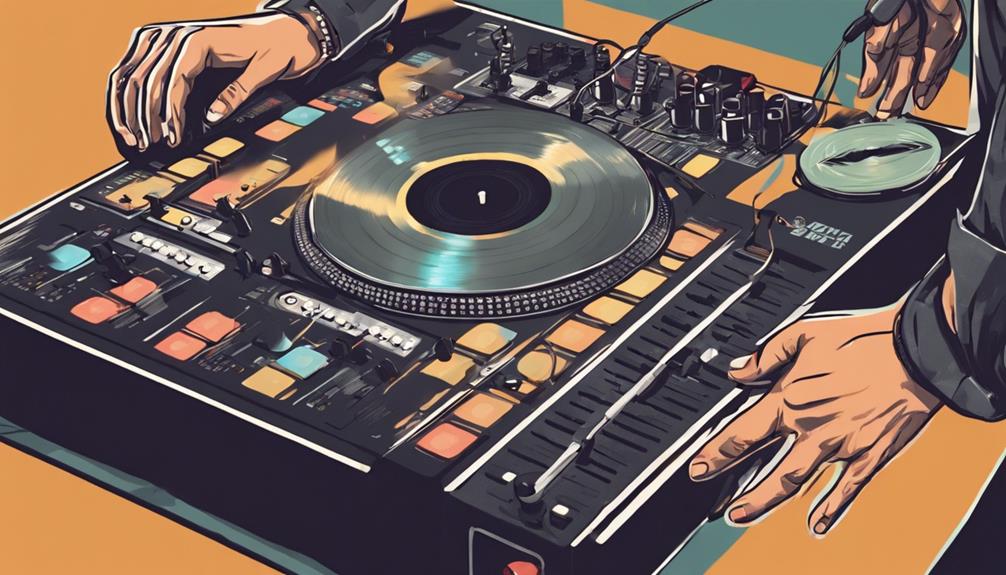No products in the cart.
To master beat matching accuracy, you’ll need to synchronize track tempos precisely. To start, identify the BPM of each track and adjust their speeds to match. Listen attentively for the dominant beats, like bass kicks, and use your headphones to cue up the next track. Adjust the jog wheel minutely to guarantee the beats align perfectly. Consistently practice setting and adjusting your cue points for flawless changes. Additionally, fine-tune the pitch controls on your CDJs in small increments to maintain consistent tempo across tracks. This detailed approach not only prevents rhythm clashes but also smooths out your progressions, enhancing your overall performance. As you continue, these skills will grow, amplifying your abilities as a DJ.
Key Takeaways
- Use BPM counters to ensure precise tempo matching between tracks.
- Adjust pitch controls minutely to synchronize beats accurately.
- Practice setting and adjusting cue points on strong beats for seamless transitions.
- Employ ear training techniques to detect subtle differences in tempo and rhythm.
- Utilize phrase matching to maintain rhythmic coherence across track transitions.
Understanding Beat Matching Fundamentals
To master seamless DJ blending, you’ll need to grasp the fundamentals of beat matching, which involves synchronizing the tempo and beats of two tracks. This technique not only requires critical listening skills but also a deep understanding of the structures of the tracks you’re mixing.
Beat matching techniques hinge on the ability to first identify the tempo of each track, typically measured in BPM. You’ll then adjust the speeds using your DJ equipment to guarantee both tracks play at the same tempo. However, achieving tempo synchronization is just the first step. The more challenging aspect is aligning the beats exactly so that they hit at the same time.
To do this, you’ll listen for the prominent beats in each track. These are usually the bass kicks, which are more audible. Using your headphones, cue up the next track in your mix, find its first beat, and adjust the jog wheel to either delay or advance the beat. This manual adjustment helps in syncing the beats precisely, ensuring a smooth flow. Remember, the goal is to make these adjustments subtly; your audience shouldn’t notice that you’re aligning the tracks, only that the music flows effortlessly.
Importance of Tempo and BPM
Understanding the importance of tempo and BPM is essential, as they are the metrics that determine the speed and rhythm essential for synchronizing tracks effectively in your DJ mixes. When you grasp tempo accuracy and master BPM synchronization, you’re guaranteeing that each track you blend moves seamlessly into the next, maintaining the dance floor’s energy without jarring changes.
Here’s a quick glance at how these elements play into your mixing:
| Element | Importance in Mixing |
|---|---|
| Tempo Accuracy | Ensures rhythmic alignment, avoiding ‘train wrecks’. |
| BPM Synchronization | Tracks match speed for smooth flow. |
| BPM Counters | Provide precise tempo readings necessary for effective beat matching. |
| Energy Consistency | Maintains vibe across tracks, essential for audience engagement. |
| Cohesive Sets | Synced BPMs lead to a polished, professional performance. |
Techniques for Precise Cueing
Mastering precise cueing techniques enhances your ability to deliver flawless shifts by accurately aligning track beats. To achieve cue point mastery, you must first understand the structure of your tracks. Identifying strong beats and phrases within the music is essential for setting effective cue points. You’ll need to practice setting these markers at precise moments, ensuring each cue point is on the exact beat to maintain timing perfection.
When it comes to executing seamless changes, the accuracy of your cue points directly impacts track precision. Use your equipment’s visual and auditory feedback to adjust the cue points minutely. This might involve shifting the cue point a few milliseconds earlier or later, refining the alignment until the change between tracks is imperceptible.
Adjusting Pitch for Synchronization
As you approach the art of beat matching, understanding how to manipulate pitch controls on your CDJs is essential. By fine-tuning the pitch, you’re able to align beats accurately, ensuring that two tracks maintain a consistent tempo.
This skill requires you to adjust pitch in minor increments, which is key to achieving seamless shifts and enhancing the overall quality of your mix.
Understanding Pitch Controls
To synchronize tracks seamlessly, DJs adjust the pitch controls on their equipment, fine-tuning the tempo of one track to match the BPM of another. Mastering pitch control techniques is essential for this process. You’ll need to develop a keen sense of how minor adjustments can either speed up or slow down a track without altering its musical key.
Effective tempo adjustment strategies involve meticulous listening and tweaking. As you manipulate the pitch slider, you’re basically altering the playback speed subtly to guarantee both tracks play at an identical tempo. This precision allows for a smooth shift between songs, maintaining the dance floor’s energy. Therefore, understanding and utilizing pitch controls adeptly is critical for any DJ aiming for flawless beat matching.
Fine-Tuning Beat Alignment
You’ll need to meticulously adjust the pitch slider to fine-tune the track’s speed, ensuring precise beat alignment for seamless synchronization. This step is critical in beat adjustment techniques and precision mastering.
As you dial in the BPM, minor shifts on the pitch slider can dramatically impact the synchronization quality. Achieving a perfect match requires a keen ear and a steady hand.
Ear Training for DJs
Developing your ability to discern subtle differences in tempo and rhythm is essential for any DJ aiming to master beat matching. This facet of DJing is deeply rooted in refining your audio perception skills. Accurate tempo recognition allows you to maintain smooth flow between tracks, ensuring that your audience experiences a coherent and enjoyable set.
To enhance your ear training, you’ll need to immerse yourself in a variety of musical styles. Each genre presents unique rhythmic patterns and tempos, challenging you to adapt and fine-tune your listening abilities. Practicing with a broad spectrum of music equips you with the flexibility to handle unexpected situations during live performances.
Moreover, effective ear training involves actively listening to the alignment of beats. You must be able to identify not only the obvious beats but also the underlying, subtler sounds that contribute to the track’s rhythm. This skill is critical as it enables you to adjust track speeds precisely and sync beats with an accuracy that feels almost intuitive.
Utilizing Phrase Matching Skills
To excel in phrase matching, you must first master identifying song structures.
This skill allows you to align rhythmic patterns between tracks, ensuring your shifts are musically coherent.
Precision in setting and triggering cue points is vital, as it enables you to execute these adjustments with sharp accuracy.
Identifying Song Structures
How can you enhance your DJ sets by mastering the art of phrase matching to identify and utilize song structures effectively?
Song structure analysis is essential; it involves dissecting tracks into manageable segments—intros, verses, choruses, bridges, and outros. This understanding enables you to predict when and where to initiate shifts, optimizing the flow of your set.
Shift planning strategies, such as deciding the best points for blending tracks, hinge on your ability to foresee these structural elements. You’ll need to recognize breakdowns and drops, leveraging them to maintain energy and engagement on the dance floor.
Aligning Rhythmic Patterns
Phrase matching, a technique where DJs align the musical structures of tracks at specific points, guarantees smooth changes during a set. You’ll need to master rhythmic pattern analysis to identify these critical junctures accurately. By understanding the inherent timing of each track, you can make precise timing adjustments, ensuring the beats align perfectly. This not only maintains the energy on the dance floor but also enhances the overall musical flow.
Employing phrasing techniques involves more than just syncing beats; it’s about musical flow harmonization. You must anticipate breakdowns and build-ups, creatively using these progressions to blend varying genres seamlessly. This strategic manipulation of song structure is essential for maintaining a dynamic and engaging set.
Cue Point Precision
Mastering cue point precision, by leveraging your phrase matching skills, allows you to mark exact locations within a track for impeccably timed changes. Here’s how you can optimize your cue points with precision:
- Cue Point Optimization: Identify the most impactful moments in a track for cue placement—think drops, breaks, or vocal entries.
- Timing Techniques: Use rhythmic patterns and beat matching to set cues that sync perfectly with the mix.
- Beat Grid Calibration: Calibrate your beat grids accurately to guarantee your cue points align with the track’s tempo and structure.
- Track Analysis: Study the structure of tracks to anticipate changes and set cues accordingly.
- Phrase Matching: Enhance shifts by setting cues at phrase boundaries for seamless mixing.
This approach ensures each shift is smooth and maintains the energy of your set.
Harmonic Mixing Explained
Harmonic mixing, a technique where DJs blend tracks in matching musical keys, guarantees smooth shifts and enhances the overall listening experience. By focusing on key shifts and musical cohesion, you guarantee that the flow between songs maintains a consistent auditory narrative, avoiding jarring changes that could disrupt the dance floor’s energy.
This method requires a solid understanding of music theory, particularly the relationships between keys. For instance, mixing tracks that are a fifth apart or within relative major/minor keys often results in a seamless, almost unnoticeable shift. You’ll find that harmonic blending not only improves the technical soundness of your sets but greatly boosts their emotional impact. When tracks are mixed according to their harmonic compatibility, the result is a more profound connection with your audience, as the emotional content of the music is amplified and becomes more resonant.
Utilizing key detection software is an essential tool in this process. It aids in quickly identifying the key of each track, allowing you to make informed decisions about which tracks to align. This technological assistance, combined with your theoretical knowledge, empowers you to execute mixes that are both technically sound and emotionally engaging.
Practice Routines for Improvement
To upgrade your beat matching skills, integrate daily beat alignment drills into your practice sessions. Utilizing a metronome enhances your tempo accuracy, training you to maintain consistent timing across varying BPMs.
Analyze your progress by recording these sessions, allowing for a detailed review of your synchronization accuracy and timing precision.
Daily Beat Alignment Drills
Implementing daily beat alignment drills, where you practice syncing the beats of two tracks, greatly sharpens your precision for smooth shifts. These routines are essential for developing your skills in beat matching exercises and tempo synchronization drills. Here’s what your daily practice should include:
- Consistent Timing Practice: Focus on aligning beats exactly to foster rhythmic precision.
- Track Variation: Use different genres to master a range of tempos and rhythms.
- Incremental Speed Adjustments: Gradually increase track tempo to challenge your synchronization abilities.
- Repetition: Repeat tracks to build muscle memory and confidence.
- Critical Listening: Analyze and adjust based on subtle sound cues, enhancing your auditory discernment.
Metronome Usage Techniques
Incorporating a metronome into your practice routines greatly enhances your ability to precisely match beats across varying tracks. By setting the metronome to your desired BPM, you guarantee consistent tempo training, essential for developing a sharp sense of timing. Practice aligning beats from different tracks while maintaining the steady rhythm provided by the metronome. This method not only bolsters your synchronization skills but also trains your ear. Gradually increasing the BPM challenges your abilities and pushes your limits, enhancing your beat matching skills further.
Despite these benefits, metronomes have drawbacks, such as potentially becoming overly reliant on visual cues. Alternatives like drum machines or software metronomes offer more complex rhythms for advanced practice, yet the basic metronome remains unmatched for foundational tempo training.
Overcoming Common Beat Matching Challenges
Overcoming common beat matching challenges, such as tempo fluctuations and track drift, requires you to refine your skills in adjusting beat grids and mastering manual techniques. These obstacles can disrupt your flow and affect your performance, but with the right approach, you can maintain smooth shifts between tracks.
To enhance your beat matching accuracy, focus on:
- Beat grid optimization: Guarantee your tracks are properly analyzed so that their grids align accurately with the actual beats. This is essential for maintaining consistency throughout your set.
- Waveforms analysis: Visually inspect waveforms for discrepancies and adjust them in real-time to prevent mismatches.
- Track drift prevention: Constantly monitor the phase alignment and make fine adjustments using the jog wheels or pitch faders to keep the tracks synchronized.
- Phase alignment techniques: Develop an ear for detecting phase issues and use your equipment’s capabilities to manipulate the timing of tracks subtly.
- Manual cue point setting: Set and adjust cue points manually to anticipate and react to beat discrepancies proactively.
Advanced Tools and Software Aids
Leverage advanced DJ software like Serato and Traktor, which offer BPM detection accurate to 0.01 BPM, to enhance your beat matching precision. These tools provide key elements for refining your mixes, ensuring each shift is seamless and on point. With such precision, you can manipulate the beatgrid with unprecedented accuracy, aligning beats perfectly even when working with complex, polyrhythmic tracks.
Additionally, consider incorporating software like Mixed In Key, which has greatly advanced in key detection technology. This tool analyzes tracks for their musical key and suggests compatible songs, facilitating harmonic mixing. This feature is vital for maintaining a consistent, engaging flow, and it amplifies your creative potential by allowing you to experiment with tracks in different but complementary keys.
Pioneer DJ’s Rekordbox also offers sophisticated features for beatgrid adjustments. Its intuitive interface allows you to tweak the grid in real-time, ensuring every beat lines up correctly. Furthermore, the sync feature in most DJ software, including Ableton Live’s warping function, supports your manual skills by providing instant tempo matching, which is indispensable during live performances when quick adjustment is necessary. These advanced tools are essential for mastering beat matching and elevating your DJing prowess.
Frequently Asked Questions
How Do I Get Better at Beatmatching?
To improve your beatmatching, you’ll need to focus on rhythmic listening and precise cue adjustment. Regular practice, using BPM tools, and experimenting with different genres will also greatly enhance your accuracy and skills.
Is Beat Matching Hard?
Yes, beat matching is challenging as it requires skill progression and is influenced by your equipment. You’ll need precise timing and rhythm, and the right tools can greatly ease the learning curve.
How to Match Different Bpm?
To match different BPMs, you’ll need to perform tempo analysis and make precise BPM adjustments. Adjust tempo sliders and use pitch controls on your DJ software to seamlessly align the tracks.
What Is the Difference Between Beat Sync and Beat Match?
Beat sync uses hardware integration and sync functionality to automatically align tracks’ tempos. Beat matching, on the other hand, requires you to manually adjust tempos, demanding more skill and precision for smooth changes between tracks.
Conclusion
As you refine your beat matching skills, remember the importance of mastering tempo control and precise cueing. Utilize pitch adjustments and harmonic mixing to guarantee smooth shifts between tracks.
Continuously train your ears and integrate advanced tools to enhance accuracy. Dedicate time to practice routines that tackle common challenges, pushing your limits.
By applying these techniques systematically, you’ll achieve greater precision in your mixes, making your performances seamless and more impactful.




